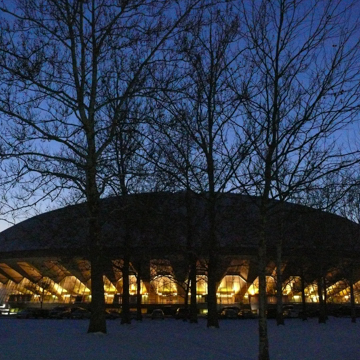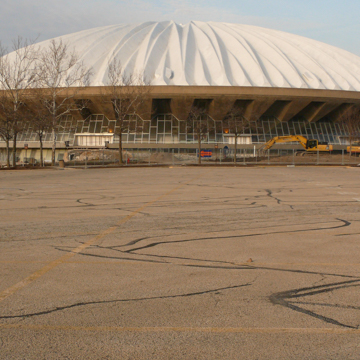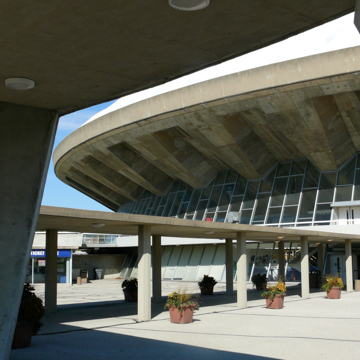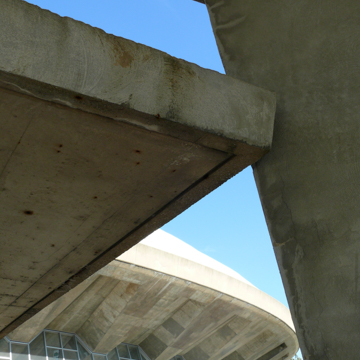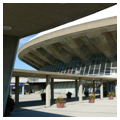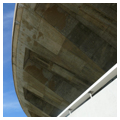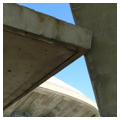You are here
Assembly Hall, University of Illinois
This modernist, concrete-domed sports arena is one of the most recognizable structures in east-central Illinois. The University of Illinois built it as a multi-purpose hall for indoor sporting events, music performances, and other large assemblies, which it easily handles with a seating capacity of 17,200.
The massive concrete structure is composed of two bowl-like forms enclosing a vast open space spanning 400 feet and rising 128 feet at its center. The roof is constructed as a folded-plate, reinforced-concrete shell, which was poured as 24 wedge-shaped sections, each 7 feet 6 inches deep. The roof sits on the rim of a concrete bowl reinforced by a 614-mile-long, 1/5-inch steel wire tension ring. The bowl’s base is set 24 feet below grade and is supported by 48 radial concrete ribs. A glazed, two-story lobby rings the perimeter of the base.
The arena is located at the southwest corner of the University of Illinois Urbana-Champaign campus—at the center of a superblock bounded by First, Fourth, Kirby, and St. Mary’s streets. To the west of the building is an oval-shaped driveway leading to a series of concrete porte-cocheres, set apart from the arena. To the east are underground offices, parking, and loading docks. Due north and south are landscaped open spaces. The remainder of the superblock is devoted to surface parking.
The arena’s principal designer was Max Abramovitz, an architecture graduate of the University of Illinois and a partner of the New York City-based architecture firm of Harrison and Abramovitz. Ammann and Whitney served as the building’s structural engineers. With its distinctive form and structural innovation, Assembly Hall is one of best examples of mid-century modernism as applied to a domed arena. The Civic Arena in Pittsburgh (1961, Mitchell and Ritchey) was built around the same time but it had a retractable roof. Houston’s Astrodome (1965, Lloyd, Morgan and Jones, and Wilson, Morris, Crain and Anderson), a much larger stadium, was not a concrete dome structure.
Very few modifications were made to the structure during its first half century of life. In 2014–2015, however, the arena underwent a $160 million renovation by AECOM that altered the interior seating from a circular (in the round) arrangement to a standard stadium scheme with luxury boxes. Mechanical systems and office space were also upgraded at this time. Fortunately, the structure’s distinctive dome-like form has been retained, both on the interior and exterior.
References
Harwood, John, and Janet Parks. The Troubled Search: The Work of Max Abramovitz. New York: Columbus University Wallach Art Gallery, 2004.
Koeper, Frederick. Illinois Architecture from Territorial Times to the Present. Chicago: University of Chicago Press, 1968.
Leetaru, Kalev. “University of Illinois: Virtual Campus Tour.” University of Illinois, 2012. Accessed September 6, 2017. http://illinois.edu.
Writing Credits
If SAH Archipedia has been useful to you, please consider supporting it.
SAH Archipedia tells the story of the United States through its buildings, landscapes, and cities. This freely available resource empowers the public with authoritative knowledge that deepens their understanding and appreciation of the built environment. But the Society of Architectural Historians, which created SAH Archipedia with University of Virginia Press, needs your support to maintain the high-caliber research, writing, photography, cartography, editing, design, and programming that make SAH Archipedia a trusted online resource available to all who value the history of place, heritage tourism, and learning.

